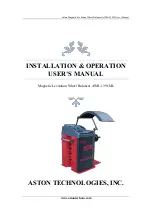
7
Ver. 05-2015
ENGLISH
Use and maintenance manual
Starting
3.
Starting
WARNING
b
efoRe
sWITchING
oN
The
mAchINe
,
mAke
suRe
ThAT
All
The
coNNecTIoNs
descRIbed
IN
The
INsTAllATIoN
chApTeR
hAve
beeN
mAde
coRRecTly
.
T
he
folloWING
opeRATIoNs
INvolve
A
poTeNTIAl
RIsk
foR
The
opeRAToR
,
GIveN
The
pReseNce
of
volTAGe
oN
The
equIpmeNT
. T
he
p
eRsoNAl
p
RoTecTIve
e
quIpmeNT
descRIbed
IN
The
INsTAllATIoN
mANuAl
musT
be
WoRN
ANd
WoRk
musT
be
doNe
WITh
due
cARe
ANd
ATTeNTIoN
.
o
peRATIoNs
mAy
oNly
be
peRfoRmed
by
A
specIAlIsed
TechNIcIAN
.
Before powering the machine, carry out the following
checks:
1. Check that the balancing machine touches the floor
at the three support points.
2. Make sure that all the parts of the balancer are cor-
rectly connected and fixed.
3. Make sure that the parameters (voltage and frequency)
of the mains power supply are compatible with those
indicated on the rating plate of the balancer.
4. Make sure the power cable is correctly connected.
5. Make sure the machine shaft and flange hole are
clean.
cAuTIoN
A
Ny
TRAces
of
dIRT
mAy
AffecT
bAlANcING
AccuRAcy
.
6. To turn on the wheel balancer press the switch on
the left-hand side of the machine.
7. Position the wheel on the terminal with the inner part
facing the balancer.
8. Firmly attach the wheel to the balancer shaft using
the lock nut.
9. At this point, you can read the tyre measurements
and perform balancing.
10. To perform the spin, lower the splash guard, when
fitted and, if necessary and available, press the
START button.
11. The wheel is automatically locked when reaching
the correct angular position for weight application
on the inside and outside.
To unlock the wheel, turn it hard to move it from the
correct correction position. If the unbalance is
within tolerance, the wheel is locked automatically.
WARNING
I
T
Is
pRohIbITed
To
Touch
ANy
pART
of
The
mAchINe
duRING
The
bAlANcING
cycle
.

























